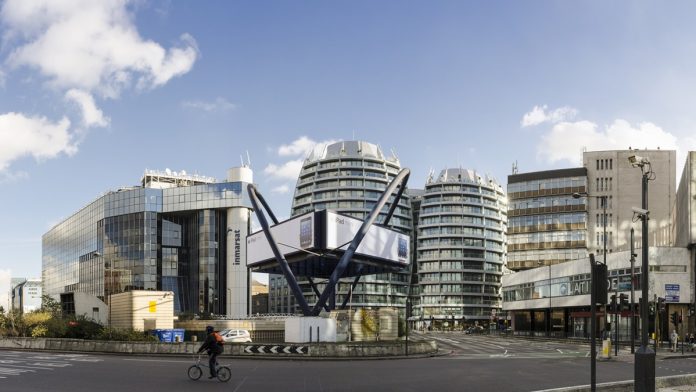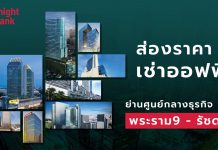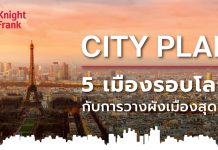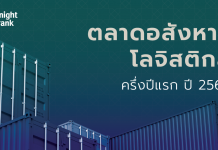The digital economy of Southeast Asia is expanding at an extraordinary pace, transforming the competitive economic landscape in an unprecedented manner. At the forefront are startups, small and medium-sized enterprises (SMEs) and entrepreneurs that are constantly innovating and utilizing technology to grow and address the increasingly dynamic needs of their growing customer base.
For Thailand, the development of the digital economy is critical if the country is to be competitive regionally and globally. Increased economic integration, improved technology and lower transportation costs are some of the numerous benefits of a growing digital economy. Private and public sector responses to the digital economy have been strong, driven by the high internet penetration rate and the large base of social media users. The digital economy impacts all market sectors, and is projected to contribute to around 25% of the country’s GDP in 2027. The resulting digital disruption challenges the business environment; market opportunities that demand groundbreaking workspace solutions are arising in the commercial property sector.

A key component of ‘Mature’ digital economies, such as the United States and UK, is the physical clustering of tech companies that serve as foundations for the digital economy. The most famous of tech clusters is California’s Silicon Valley, which has since transcended national boundaries to become a global center for technology. Other highly developed tech clusters include East London Tech City in London and Silicon Alley in New York City. Within Southeast Asia, Malaysia has invested heavily in the development of the Multi – media Super Corridor as its own tech cluster.
For Thailand, and more specifically, Bangkok, it is difficult to pinpoint a distinctive tech cluster, especially one that has grown organically without the use of traditional, area-based cluster public policies – such as designated high-technology business districts (Multi – media Super Corridor) or science parks (Thailand Science Park). Often, such approaches can be unsuitable for startups, SMEs and entrepreneurs that lack the production scale or funding of well-established tech giants. One promising project for tech firms is the newly opened True Digital Park on Sukhumvit 101.
The project provides over 38,000 square meters of space designated as “an interconnected ecosystem for startups” at a rate of around 1,300 baht per sq. m for fully fitted space. Despite the reduced capital outlay as a result of the fully fitted provision, the majority of startups and SMEs will still be priced out. On the surface, there seems to be a shortage in Bangkok for neighborhoods and commercial properties that are conducive to the development of the digital economy’s smaller stakeholders.
But often, successful tech clusters spring from overlooked and unexpected places. Take Shoreditch, a central district of the East London Tech City for example. Post WWII Shoreditch was a place associated with deterioration, poverty and crime. In contrast, 21st century Shoreditch is the place to be for tech firms, having transformed into a hub for technology and innovation, completed with lively markets, studios, galleries, coffee shops and other vibrant features. In 2011, Google turned an old dilapidated building in the area into a 2,300 square meter hub for startups. Between 2011 and 2017, average office rents increased from 1,187 baht to 2,097 baht per square meter per month, having increased by 10% annually.

A data driven approach was applied to the East London Tech City’s physical geography, demographics, stakeholders and other contributive factors to its transformation. By doing so, a deeper understanding of how tech clusters form and grow organically was gained. With this awareness, previously overlooked market opportunities for tech clusters in Bangkok were uncovered. One particular area stood out as a potential location: Praditmanutham area. Like Tech City’s Shoreditch a few decades earlier, the area has gone relatively unnoticed through the lens of tech and commercial property sectors. In reality, there are undercurrents gradually shaping Praditmanutham into a potential hotspot for the emerging digital economy.
Why are tech clusters important to the digital economy?
It is beneficial for tech firms to be located in close proximity to one and another. Clustering allows firms to quickly establish a comprehensive network of suppliers, customers and collaborators, talent and critical infrastructure, creating a value chain. The exchange of knowledge and new perspectives between firms and workers in close geographical proximity lead to improvement, innovation and change that are critical for firms looking to build and maintain a competitive advantage. Knowledge spillovers as a result from contact with other firms and institutions are not limited to just technological productivity. It can lead to positive changes in firms’ management, marketing and organization structures. This is highly beneficial for startups and SMEs that can draw on a range of perspectives and experiences of their well-established peers.
East London Tech City
Although no officially defined boundaries have been set, research conducted by the Centre for London think tank has established that East London Tech City is a cluster of high-tech companies that broadly occupies the areas between the London boroughs of Islington, Hackney, Tower Hamlets and the City of London. The ‘core’ of the cluster is the group of firms located in the district of Shoreditch, which sits between Hackney and Tower Hamlets, slightly above the City of London.

Shoreditch has a rich industrial history, concentrated in the areas of furniture, textiles, jewelry, printing and design. Towards the end of the 19th century, the area experienced a decline in economic conditions, as textile and furniture companies struggled to compete against their competitors located elsewhere.
The area became associated with poverty, prostitution and crime. Conditions worsened as a result of WWII, leaving properties vacated and in states of deterioration. In the 1980’s however, the area attracted service led companies and creative industries that helped bring about a process of de-industrialization. Warehouses were transformed into offices, flats, pubs, bars, art galleries, restaurants and so forth. Many of the firms established during these times remain operating in East London Tech City to this day.
However, the area was still relatively run-down in comparison to the rest of the city. In 2008, there were several tech companies located in the area, including the social networking service company Dopplr. The company’s CTO Matt Biddulph sarcastically coined the term “Silicon Roundabout” to refer to the disorganized but congenial cluster of tech companies in the rundown, uninspiring Old Street roundabout, situated just above the city of London.

2010 marked the emergence of the tech cluster that is present today, with PM David Cameron announcing ambitious plans to develop Inner East London into a global tech hub.
“Our ambition is to bring together the creativity and energy of Shoreditch and the incredible possibilities of the Olympic park to help make East London one of the world’s great technology centers”
David Cameron, Former PM of the United Kingdom (2010 -2016)
The Tech City strategy includes: Supporting SME’s and startups clustered in the area, attracting large international investors, and guiding high-tech activity further east, including into a post-Games Olympic park. The strategy was backed by several policies that are beneficial to tech companies including an Entrepreneur Visa, lowered costs of financing for SMEs, tax breaks for venture capital, seed funding and video games, improved broadband network and a Launchpad competition for digital firms.

East London Tech City has attracted a large number of technology firms to the area throughout the years, ranging from startups to multinational firms. Google created an innovation hub to support tech startups and develop next-gen applications and services in 2011. Meanwhile, Amazon opened its Digital Media Development Centre in 2017. Financial and professional service providers that support tech companies have also established a strong presence in tech city. For example, the global technology and business consultancy company Capco relocated its headquarters to the area, and is currently supporting small FinTech startups through dedicated office space.
Tech City Sector Breakdown
Breakdown of IEL digital content sector 2010
Breakdown of IEL ICT sector 2010

Source : Centre for London
The exact number of tech companies in the cluster is often disputed between various sources, given the cluster’s continuously changing boundaries and difficulty in classifying firm types. According to the Centre for London think tank, the number of ‘digital economy’ firms has doubled since 1997 to 2010, increasing from 1,591 to 3,289. Meanwhile, the rate of employment relating to the digital economy more than doubled during the same period, increasing from 12,931 to 48,586 jobs. This is a higher rate of increase than for the city of London as a whole.
The cluster sector composition can be divided into two main constituents. These first is Information & communications technology (ICT), which includes systems (broadband networks), hardware (computers), software and services (sales, installation and maintenance). The second is digital content (such as publishing, advertising, design, music and broadcasting media). The ICT sector is dominated by telecoms, which takes up approximately 75% of jobs followed by office repair/other office and computer hardware consultancy. The digital content sector is much more diverse, with notable contributions from software consultancy and supply, advertising, radio and TV/news and publishing.
Tech City Firm Age & Size
Firm’s Age Profile

Firm’s Size Profile

The majority of firms located in East London Tech City are younger firms, which aligns with expectations that the tech cluster is attractive for startups and SMEs. Around 62% of firms surveyed by the Centre for London are 5 years old or less. Over half of the sample can be classified as micro-businesses (less than 10 employees), a third are small firms (11 to 50 employees) and a minority are medium-sized businesses. Around a third had an international structure, with either units or a parent enterprise located in another country.
Demographics within firms can be indirectly identified through the profile of founders of companies located in the cluster interviewed by the Centre of London. The majority of personnel surveyed are in the ’20s to late 30’s age range (80%). A minority are in their 40’s, having previously worked with 2 – 4 companies. Overall, this puts the majority of personnel in the 20 – 44 age bracket. The sample is also highly educated; the majority has a degree, with about 1/3 attaining postgraduate qualification. For companies with co-founders, several have links stretching back to their university days.
The Hackney and Tower Hamlets borough profiles shed light on the occupants of tech city. Tower Hamlets in the mid-20th century was marked by disinvestment and mass exodus. From 1971 to 1981, the population declined by 15%. In contrast, from 2007 to 2017, the population of Tower Hamlets increased by 37%. This was the fastest population growth rate amongst all 391 local authority areas in UK. The borough has a median age of 31 years, with 54% of the population in the 20 to 44 years age range. This is well over the average of 34% in1981 and the current London average of 41%. It indicates that Tower Hamlets now has a distinctively young to middle-age population. Household size in the borough is also relatively small. Approximately 35% of households in 2018 are single person households, higher than the London average of 32%.
The Hackney borough profile tells a similar story. Mid-20th century Hackney was also characterized by decline in population and level of economic activity. From 1971 to 1981, the population declined by 19%. In comparison, it increased by 21% between 2001 and 2011. Approximately 35% of households in 2011 are single person, higher than the London average of 32%. Over 50% of Hackney residents are in the 20 to 44 age range, up from 35% in 1981. Overall, these numbers indicate that Tech City attracts single, young professionals.
Tech City Borough Population

Tech City Borough Profiles

The majority of businesses located in both Tower Hamlets and Hackney are relatively small in size. 90% of businesses in both boroughs are micro-businesses (less than 10 employees), higher than the average of 88% across London. 8% of businesses in Tower Hamlets are small firms (between 11 to 50 employees. On the other hand, only 0.5% of businesses are large businesses which employ 250+ people. The borough is characterized by a wide range of local businesses from small family companies, creative, startups, light manufacturers and SMEs. Unsurprisingly, the profile of jobs in both boroughs is dominated by those directly contributing to the digital economy. Two thirds of jobs in Tower Hamlets are classified as ‘knowledge intensive’ or ‘high tech industries’. In both boroughs, ‘professional, scientific & technical’ and ‘Information & communication’ are the two largest sectors, combining to 44% of businesses in Tower Hamlets and 46% in Hackney.
Businesses in Hackney by Broad Industry

Businesses in Tower Hamlets by Broad Industry

So what attracted the various firms and workers to the cluster? For older firms, the decision to establish a presence in the area was coincidental. At the time, there was no identifiable tech city strategy in place. Some of the founders lived in the area or nearby, or were attracted by lower rents offered in the area. Co-working spaces played a role in attracting tenants, as they typically offer lower rents than serviced offices. Ironically, the decline in economic quality and population in the area led to lower rents, which created an opportunity for older tech startups to move into tech city. This suggests that fundamentally, older firms were driven by lower costs and familiarity with the local environment.
Meanwhile, younger firms were more deliberate in their decisions to relocate. Employees are much more involved property decision-making processes as modern day firms recognize that real estate decision are crucial in attracting and retaining talent. This is a worldwide phenomenon well documented by (Y)our Space, Knight Frank’s flagship report on global trends shaping occupational markets:
“Attitudes toward real estate costs are changing, as focus shifts towards effective rather than cheap real estate solutions.
(Y)our Space, Knight Frank flagship report (2018)
Firms are now aiming to increase efficiency by strengthening the bonds between people and property. Younger firms were partly drawn to tech city due to its amenities. Tech city has “lots of bars and lots of places you can eat” and “lots of takeaway options and lots of places to hang out in the evenings,” referring to the various restaurants, cafes and bars available in the area. Access to food and social activities is important for the young, energetic workface often identified in tech startups.
Firms also cited other positive features of tech city, including other like-minded/complementary firms, branding and messaging, cheap office space and close proximity to central London. Notably, rent is still an important factor in the real estate decision, but doesn’t tell the entire story – There are other non-monetary factors considered as well.
The area’s amenities such as cafes, bars and shared workspaces provide firms with an extensive range of networking and collaborative opportunities. This level of exposure is unique to tech clusters; complementary firms and workers sharing the same spaces. It leads to the exchange of knowledge, information and resources that benefits all parties involved. Firms say that they have recruited from shared workspaces, sought and received advice on technical and business development issues, and met with investors in the area.
Praditmanutham
Spanning 12 km, from the end of Soi Sukhumvit 63 (Ekkamai) to Ram Intra, one major road connects downtown Bangkok to the northeastern suburbs of the city. After several name changes over the past few decades, the road received its current designation as ‘Praditmanutham road,’ after the royally conferred title to Pridi Banomyong, known to many as ‘The Father of Thai Democracy.’ Praditmanutham intersects 3 notable districts which are Lat Phrao, Wang Thonglang and Bang Kapi. These three districts have a combined population of 377,843 people and span 68.9 km2.
Praditmanutham District Map

The population of all three districts has been steadily declining over the past decade. From 2009 to 2018, the total population declined by 10,407, representing a 0.30% decrease. Over the same period, the population of Bangkok declined by 0.05%. This suggests that over the past 10 years, there has been a shift in population away from the Praditmanutham area. While often viewed as a negative trait, population decline can lead to new opportunities as well. Tower Hamlets and Hackney both experienced this prior to the formation of the tech cluster, albeit at much higher levels. As the tech city experience demonstrates, population decline can provide opportunities for the growth of smaller firms attracted by lower rents in the area.
Praditmanutham Office for rent <<<
Praditmanutham District Population

Although over 50% of the population in present-day tech city is in the 20-44 age range, it was only at 34% in 1981. Meanwhile, 37% of the current Praditmanutham population is in this age range, which is 3% higher than Tower Hamlets and Hackney pre-tech city. This indicates that there is potential for youthful population growth in the three districts. However, it should also be pointed out that the Praditmanutham age profile is skewed towards an older population. This is a reflection of the fast-ageing Thai population that has resulted in a top-heavy age distribution for all Bangkok districts. It is possible that organic Thai tech clusters will be formed by an older population. There are a few other districts with slightly higher population concentrations in the 20-44 age range.
Most noteworthy is the neighboring district of Huai Khwang at 41%. The district also benefits from a good level of connectivity via the MRT and close proximity to the CBD. However, office rents in the area are rising rapidly, having increased by an astounding 40% over the past 5 years due to developments under the “new CBD” branding for the Rama 9 – Ratchadaphisek intersection. Small to medium sized tech companies will likely be priced out of the area over the next few years, which will be a major obstacle to any potential tech cluster formation.
Praditmanutham District Age Profiles

From data on business transactions conducted by legal entities in 2016, it can be inferred that the majority of businesses located in the Praditmanutham are small to medium in size. The ministry of commerce classifies small businesses as those with fixed assets not exceeding 50 million baht. Meanwhile, medium sized businesses are those with fixed assets between 50 million baht and 200 million baht.
An average business in Lat Phrao and Wang Thonglang has total assets below 50 million baht, while an average business in Bangkapi has 52 million in total assets. It is therefore reasonable to conclude that the majority of businesses in the Praditmanutham can be classified as SMEs. The area has a solid local business base in the appropriate size to initiate the organic formation of a cluster, although it is unclear how many of the businesses are focused on tech or creative type businesses.
Business Conducted by Legal Entities in Praditmanutham Districts

New business registrations by legal entities are well above the Bangkok average of 27 per district. Bang Kapi alone approved 57 registration applications, over twice the city average. Despite population decline, there is a relatively good level of economic activity in the area as new businesses are formed at a high rate.
Meanwhile, Wang Thonglang and Bang Kapi rank within top 10 for highest government expenditure budget amongst all 50 districts in Bangkok. In all three districts, the Y-o-Y growth in the budget exceeded the Bangkok average of 2.9%. Spending is allocated towards wages, social welfare, education and other forms of capital investment in the districts, which will lead to the improvement of economic conditions in the area.
New Business Registrations by Legal Entities in Praditmanutham

As East London Tech City makes evident, amenities are crucial for attracting tenants to the area. In terms of quantity, retail amenities exceed the Bangkok average in almost all areas for all three districts Most notably, Bang Kapi alone is home to 10 shopping centers, far exceeding the Bangkok average of 3 per district. Apart from sources of local revenue, shopping centers also act as key activity centers in the social component of communities, elevating their purpose beyon merely places to buy things.
The Praditmanutham area hosts several high-quality shopping centers, a positive amenity feature exceptionally rare for areas outside the CBD. Most notable are Central Festival Eastville, Crystal Design Center and the Crystal Ekamai – Ramindra, which combine to over 250,000 square meters of retail gross floor area right on the main road. The Praditmanutham area hosts a variety of other recreational amenities such as an RC race track, a bike park and several football pitches for rent. The corner (Hua mum) market in Lat Phrao offers a cheaper, open air alternative to the enclosed shopping malls. The Praditmanutham nightlife scene is also quite active as there are plenty late night restaurants, pubs and clubs that cater towards a younger population. Overall, the level of amenities available suggests that the area would be well equipped for the young, sociable and energetic demographic commonly identified in tech firms.
Retail Amenities in Praditmanutham Districts

Within a 6 km. radius, with the Central Festival Eastville – Crystal Design Center area as reference point, only 9 office buildings have been identified. Only 2 buildings are actually located within the three districts; none are on Praditmanutham road. Currently, despite the tech cluster friendly local environment, there is a shortage of high quality office space in the area. Without the appropriate commercial space available, a tech cluster cannot form naturally. There is a critical need for a response from the property sector to the challenge posed by the digital economy.
Praditmanutham Office Comparables

Reference Point
Central Festival – CDC
Office Comps
1. 111 Pradimanutham
2. Jitt Uthai Building
3. Tasniya Buidling
4. Le Concorde Tower
5. Sermsrap Building
6. Preecha Complex
7. Olympia Thai Tower
8. V Office Building
9. Rasa Tower l & ll
One particular obstacle impedes the development of office space in the Praditmanutham area; the lack of access via public transportation. Using the Central Festival Eastville – Crystal Design Center area as a reference point, the closest MRT is approximately 6 km away, which can turn into a 30 minute car ride during rush hour.
This could be a key deterrent for a significant portion of employees that prefer to travel on foot or via BTS/MRT Fortunately, there are major transportation infrastructure projects in progress that would significantly increase connectivity to the area. Most notable are the construction of the MRTA pink and yellow lines which are scheduled to open in 2021, and the planning of the monorail grey line.
Our research indicates that the Praditmanutham area has many positive qualities that can foster the clustering of small to medium sized tech companies in the area. However, there are still several issues to be addressed by both the government and the commercial property sector in order for this to happen. Transportation infrastructure has to be created in the area to increase access for non-car commuters.
Meanwhile, property developers have to identify the enormous untapped potential of Praditmanutham to supply office space to entities at the forefront of the digital economy. Perhaps, some already have; KE group’s 111 Praditmanutham is expected to add approximately 10,800 square meters of office space right between Central Festival Eastville and the Crystal Ekamai – Ramindra on the main road. As East London Tech City has demonstrated, vibrant tech hotspots can emerge from the most unexpected places. It also makes clear that successful tech clusters are complex environments that take time evolve and grow; a lot of phases need to be completed to make this a reality.
Praditmanutham Mass Transport Routes

Download the PDF file, click here The Rise of Tech Cluster













